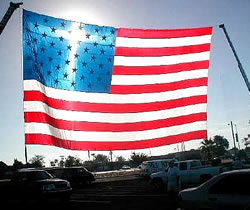 |
| Dominion Theology |
But what this involved was far from clear. In part, it entailed a defense of the evangelical subculture against what was seen as a secular humanist conspiracy. But it also involved attempting to reverse recent legislative changes, particularly as regards abortion, and some in the Christian Right harbored more ambitious aspirations still.
The United States, they argued, had originated as a Christian nation and in the future its institutions should be based on the Bible. In arguing this, the more intransigent elements in the Christian Right were drawn to a range of theories about the relationship between God and government that are collectively known as Dominion theology.
The central biblical text for Dominionists is Genesis 1: 26–28, where God declares that man shall have dominion over all the earth. This is seen as directing believers to create both a Christian government and a Christian culture and has been particularly associated with a school of thought known as Reconstructionism.
 |
Founded by a Presbyterian thinker, Rousas John Rushdoony, Reconstructionism argues for a free-market economy, the ending of government-provided education and welfare, and, most controversially, the restoration of Old Testament sanctions that will include the death penalty for murder, adultery, homosexuality, and incorrigible juvenile delinquency.
In 1965 Rushdoony founded Chalcedon Inc., subsequently the Chalcedon Foundation (named after a fifth-century church gathering), but it was not until the 1980s that Reconstructionism began to attract attention from within the broader Christian community. By this time, Rushdoony had broken with his son-in-law, Gary North, who would become a particularly prominent publicist for Reconstructionism through his Institute for Christian Economics and his authoring of a number of books.
A third figure, Gary DeMar, and his group, American Vision, were another crucial element in the movement, while a broader organization, the Coalition for Revival, was set up to bring together Reconstructionists with other adherents of Dominion theology.
Some members, unwilling to adopt the full Reconstructionist argument, resigned from the organization, and another dispute, which broke out at Pat Robertson’s Regent University Law School, led to the removal of its dean.
Tensions among Dominionists have emerged around a number of questions. Where Reconstructionism was particularly associated with Presbyterian churches, charismatic Christians (distinguished by their belief in “speaking in tongues” and divine healing) represented a different tradition.
There were differences, too, over how the so-called creation mandate found in Genesis related to the return of Christ. Most evangelicals believed in what was called premillennialism, that Christ’s return would precede the bringing about of Godly government and then a final battle with Satan. Reconstructionists, however, were postmillennialists, believing that they would come to power before the Second Coming.
Within this milieu, conspiracy thinking found a ready audience. Rushdoony himself was a supporter of the John Birch Society, while North wrote the epilogue to a conspiracist text by the John Birch Society author, Larry Abraham. Subsequently publishing a version under his own name, North declared that the enemies of the United States were “a conspiracy of super-rich and super-powerful insiders.” But behind them, he declared, was Satan himself.